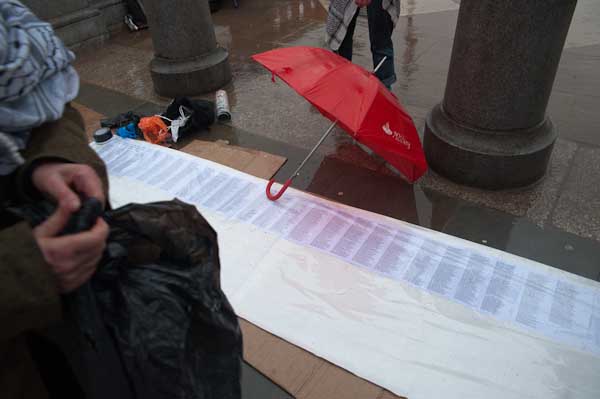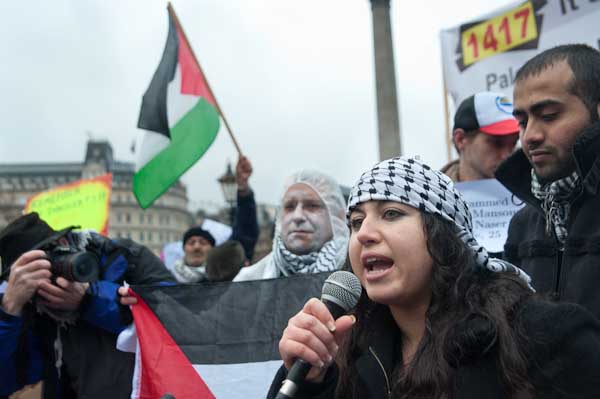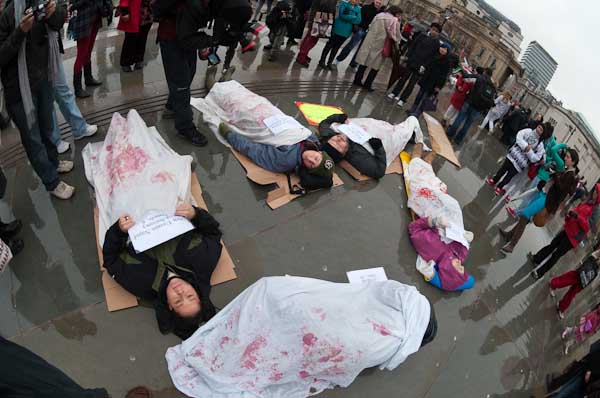Yesterday was too wet for a die-in. The International Solidarity Movement had hoped to get 1417 people to lie down on the paving in Trafalgar Square as a graphic reminder of the 1417 men, women and children killed during ‘Operation Cast Lead‘, the 22 days of Israeli attacks on Gaza a year ago.

All 1417 names on the list
The figure is disputed and comes from the Palestinian Centre for Human Rights, with the Israeli human rights organisation B’Tselem giving a slightly lower figure of 1387 and official Palestinian and Israeli sources differing rather more. But a great many certainly were killed, and the great majority of them – over a thousand – were non-combatants. Again the two more believable sources give figures of 313 or 320 children in the overall figure. By contrast there were 13 Israeli deaths, including three soldiers killed by “friendly fire.”
(The figure of around 1400 is in one respect an underestimate, in that Palestinians are dying all through the year as a result of the Israeli blockade limiting their access to medical treatment; deaths due to this cause in the 22 days are not included in the estimates.)
Unfortunately due partly to the lousy weather with heavy rain rather fewer than expected turned up. Well under half of those who had signed up on Facebook as coming actually turned up to collect the names they had been allotted, though fortunately there were quite a few who for one reason or another hadn’t signed up. But for whatever reason the event was still well over a thousand people short. Although it seemed quite a sizable crowd in a corner of the North Terrace, it was still perhaps only a fifth or less of the number who died in Gaza.
Not only was it too wet to lie down on the pavement, it was also really too wet for photography, at least as the event started. I was walking around holding up an umbrella with one hand and a camera with the other. An umbrella is a real pain, particularly in even slightly crowded situations for the way it limits your mobility. Photography, or at least this kind of photography, is all about getting into the right place to take pictures. Well at least that’s the sine qua non. “F8 and be there” is all very well (so long as you realise that being there sometimes needs almost millimetric precision) but you still need to release the shutter at the right time.
You need to learn how to get through small gaps in crowds fast, to slide into positions, to duck and weave to where you need to be, but really it’s impossible when you are holding an umbrella, and particularly so when everyone else is.
And then there’s the lack of a third hand to hold and use the cloth that you will need – even under an umbrella – to wipe the drops of rain off the filter. I use a microfibre cloth that isn’t bad, but really a genuine chamois leather is still better, though it costs several times as much. I went for the false economy and regret it every time it rains.

Fortunately the rain stopped for the speeches
I think almost all of the pictures were taken on program setting, though several times I used the “flexible program” facility, turning the handy thumb wheel to change the aperture or shutter speed. I was also working on ‘”Auto ISO” with the camera ISO set as ISO 800. The light was dim but changing, giving some quite varied settings. There were rather too many frames where the Sigma 24-70 was wide open at f2.8, and slightly higher lower ISO setting might have been better. The lens is usable wide open, but noticeably better at f4. I would welcome the ability to set a maximum lens aperture at which the ISO starts to increase when in Auto-ISO mode. With this lens for normal use I’d like it to start increasing ISO at f4 and only open up to f2.8 once the upper ISO limit had been reached.

Anti-Zionist flag burning has become a ritual
I had thought wrongly that AutoISO worked with the set ISO as the minimum and was surprised to find some of the pictures I took had used a lower ISO – down as low as 320 in at least one case. In fact the vast majority of images were taken at ISO 800, although according to the manual the lower limit when using AutoISO is always ISO 200. But ISO 800 was a better base to work from under the light conditions, so I’m pleased it seems to do so, though mystified why it chose to use lower values for these particular frames rather than simply alter the aperture and shutter settings as it could have done.

A few people did stage a die-in for the cameras at the end of the event
Incidentally Nikon did release a firmware update for the D700 recently, which I’ve downloaded and applied and recommend; if you have a D700 you should now be using Firmware Version 1.02.